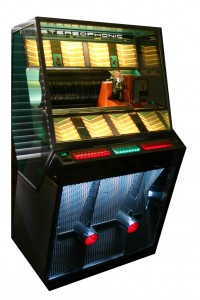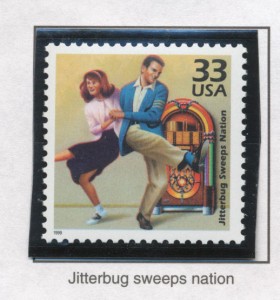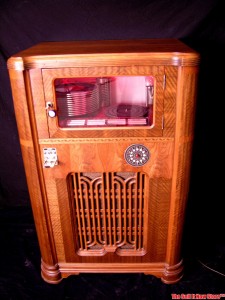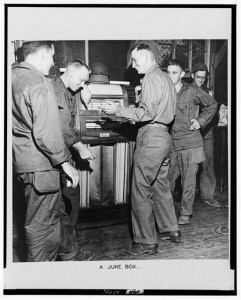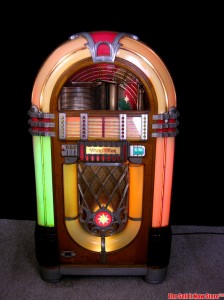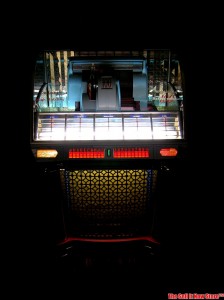Jukeboxes and Collecting Make Beautiful Music Together
It commands attention: this icon of the 1950s is outfitted with sparkling chrome, flashy fins, gleaming bumpers, taillights and a dashboard-style console that’s surrounded by a glass windshield. A 1958 Chrysler Imperial? Nope. A 1958 Seeburg Silver Age jukebox.
The 1950s were the peak of America’s love affair with both automobiles and jukeboxes. Eisenhower pushed for an interstate highway system (“defense highways”) to be built, and drive-ins, motels and sleek aluminum-shelled diners began to pop up all over the landscape. Each business housed one or more jukebox, with designs heavily influenced by the autos coming out of Detroit. Like cars, the jukeboxes of the 1950s were sleek and streamlined.
Nothing says “fifties” quite like a jukebox. Back then, they were found everywhere people gathered: restaurants, bars, community centers, malt shops, military PX’s, even Laundromats. For a little pocket change, any gathering could be turned into a dance party. As long as patrons continued to pump the ‘box full of coins, it would play all night, commercial-free and with greater musical variety than could be heard on a radio. Young baby boomers would beg their parents for quarters for the jukebox in the same way that boomer’s children would beg for quarters for the video arcades in the 1980s and 1990s.
America’s passion for jukeboxes lasted about 30 years. The popular 1963 jukebox hit “Turn Around” by Harry Belafonte (“Where are you going, my little one? …Turn around and you’re gone”) might also describe the demise of the jukebox. At my favorite beach hangout in the mid-1990s, I noticed that jukeboxes weren’t found in all the usual places. Restaurants and other venues were playing pre-recorded “mood music” delivered by MP3 players. Bars had big-screen televisions. Technology had moved on, and jukeboxes had become as rare as pay phones—at least in public.
Jukeboxes have moved from barrooms and malt shops into the basement rec rooms of America. They’ve become a favorite collectible, and it’s not unusual for collectors to have a half-dozen or more of these shiny chrome pop icons in their home. For most, collecting jukeboxes fosters another hobby: record collecting. Not all jukeboxes play the 45-rpm records that boomers are familiar with, so jukebox collectors develop a sharp eye for records that will fit their machines.
Like many manufactured icons, the rise and fall of the jukebox is closely tied to the American economy and social mores.
Coin-operated automatic phonographs have been around since the late 19th century—Thomas Edison created one. But the Automatic Musical Instrument Corporation (AMI) invented what is generally recognized as the forerunner of the modern jukebox in 1926. Early jukeboxes looked much like the radio consoles of the day: big, wood-veneered cases with cloth-covered speaker grills. They played 78 rpm records, and the selection could be customized to the clientele of the joint: jazz, hillbilly, pop or “race” music. Jukeboxes came to be associated with speakeasies, as reputable venues preferred to feature live music.
When Prohibition ended in December 1933, the bar business boomed and with it so did sales of jukeboxes, at least until the market topped out. It seems that the jukebox manufacturers were making solid, reliable machines and bar owners saw no reason to upgrade when new models came out. Toward the end of the 1930s, jukebox sales plummeted and manufacturers were forced to adopt very liberal trade-in policies in order to sell new machines. Once the trade-ins were back in the factory, most of them were disassembled for parts or destroyed. Consequently, some jukeboxes from the late 1930s, especially Wurlitzers, are hard to find.
America’s entry into the Second World War caused millions of young soldiers to be relocated to camps all over America and overseas. To keep up morale, the Armed Forces installed hundreds of jukeboxes in PXs and service clubs and stocked them with music to suit every ethnic background. Blues, gospel, country and pop records were all combined on any given jukebox. Music that was never heard on the radio was readily available to America’s soldiers so that all might have a taste of home. By the end of the war, fully three-quarters of all records produced in America were going into jukeboxes.
Whenever troops came home from overseas, they brought with them a penchant for pumping coins into a jukebox and partying wherever they happened to be. By 1956, there were about 750,000 jukeboxes swallowing up dimes in America.
Production estimates for the top four jukebox manufacturers—Wurlitzer, Seeburg, AMI and Rock-Ola—show that there were nearly two million units manufactured in the United States between 1935 and 1979. Most of these are rusting away in landfills, but there are tens of thousands still available for collectors and enthusiasts.
I spoke recently with Michael Boerschinger, owner of the Sell It Now Store in Wauwatosa, Wis., and he told me that the secondary market for jukeboxes is alive and well. In the past two years, Boerschinger has sold more than 200 jukeboxes, many to buyers as far away as Australia, New Zealand, Northern Europe, France, Italy and Germany. How does he have such a wide reach? Mike is a licensed auctioneer who’s well versed in online selling; he knows how to get the job done for his consignors. The Sell It Now Store is the fifth largest eBay drop-off store in the US and sells not just jukeboxes but also a host of other items including classic cars, coins, silver and vintage guitars. Mike has quite a following in his market, due in part to his Sunday afternoon radio show “Sell It Now Radio” on 1340 WJYI-AM in Milwaukee.
Many of Mike’s jukebox consignments come from his hometown. When Milwaukee’s bars and restaurants started to shed jukeboxes, they were scooped up by the town’s World War II and Korea veterans and turned into home entertainment centers. As that generation passes, many of their baby-boomer heirs are more inclined to sell the jukeboxes. Mike is the go-to guy for getting those ‘boxes sold.
Mike’s tips:
• The most popular jukeboxes are those made after 1960, especially ones where users can see the record mechanism in action.
• To determine an approximate value for a particular jukebox, move the unit away from the wall and note the make and model on the tag on the back. Then check that information on eBay.
• Always get a second opinion of value. Mike tells of a friend who sold a rare jukebox for $400 that later sold for close to $30,000. Mike welcomes phone calls with questions about jukeboxes and values.
• Repair manuals and parts are readily available for most models, and repair people can be found in most states.
What are jukeboxes worth? Like other collectibles, that depends on rarity, demand and condition. Here are some jukebox values, based on recent sales at the Sell It Now Store:
• 1935 Wurlitzer P12: The second Wurlitzer model produced; $1,200 to $2,400
• 1941 Wurlitzer 800: Golden age, Paul Fuller design; $5,500 to $8,500
• 1946 Wurlitzer 1015: Golden age, most popular jukebox of all time; 60,000 produced, Paul Fuller design; $3,500 to $6,500
• 1946 Wurlitzer 1080: meant for finer locations, golden age, Paul Fuller design; $3,500 to $6,500
• 1948 Wurlitzer 1100: Golden age, last of Paul Fuller designs; $3,000 to $5,500
• 1953 Seeburg HF100G: Model used in “Happy Days” TV Show; silver age; $2,000 to $4,000
• 1954 Wurlitzer 1700: Silver age; $2,000 to $4,000
• 1955 Wurlitzer 1800: Silver age; $2,500 to $4,500
• 1956 Wurlitzer 1900: Silver age; $3,500 to $5,500
• 1956 Wurlitzer 2000: Silver age; the most desirable 1950s Wurlitzer; $5,000 to $10,000
• 1957 Wurlitzer 2100: Silver age; the second most desirable 1950s Wurlitzer;
• $5,000 to $10,000
• 1959 Wurlitzer 2300: Silver age; $3,000 to $4,000
• 1960 Rock-Ola Tempo II: Silver age; $3,000 to $4,000
• 1961 AMI Continental II: One of the most desirable AMI jukeboxes; $4,000 to $6,000
• 1962 Seeburg AY160: End of silver age; $1,500 to $3,000
Wayne Jordan spent more than 40 years in the music business as a performer, teacher, repairman and music store owner. In 25 years of musical instrument retailing he has bought, sold, rented or repaired thousands of pianos, band & orchestra, combo, and folk instruments. Wayne is currently a Virginia-licensed auctioneer and certified personal property appraiser. He blogs at SellMoreAntiques.net
WorthPoint—Discover Your Hidden Wealth



